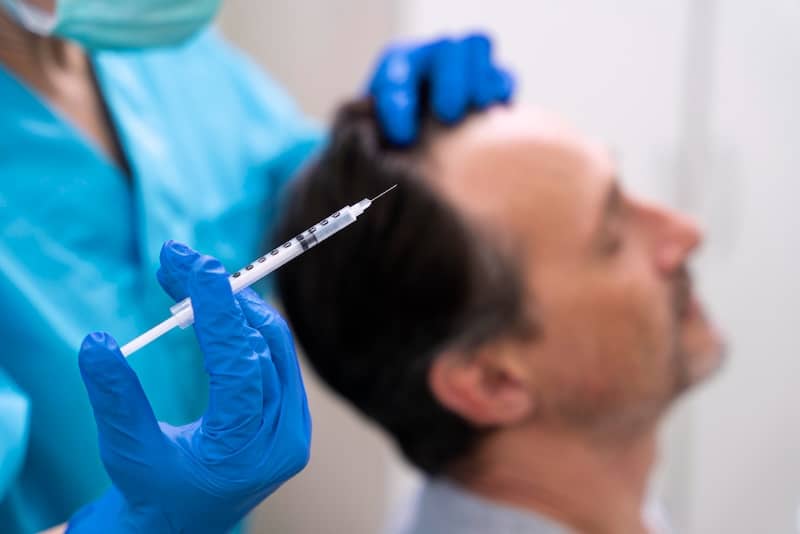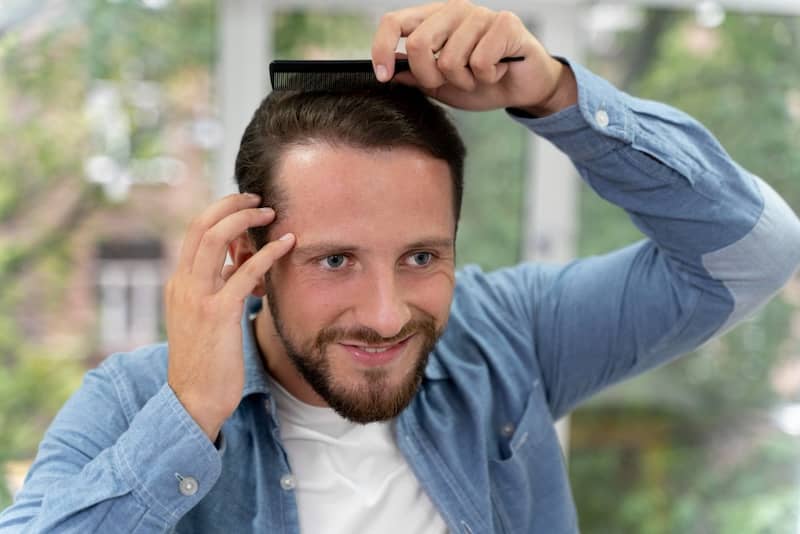
What to Expect During Recovery From SmartGraft Hair Restoration
SmartGraft hair restoration is one of the most advanced, efficient, and minimally invasive hair restoration techniques available. It can restore the appearance of your natural hair and boost your confidence in the process.
Just because it’s cutting edge, doesn’t make scheduling surgery any more comfortable, though. We get it. Understanding what to expect after your surgery can help you prepare and get excited for your hair restoration surgery.
Some common questions we hear include: How long will it take? When can I get back to work, hit the gym, or enjoy time outdoors without worry? Understanding the SmartGraft recovery timeline is essential to setting appropriate expectations and achieving the best results possible.
Why SmartGraft Recovery Is Different From Traditional Methods
Unlike older hair transplant methods that require removing strips of scalp—often leaving visible scars and requiring weeks of downtime—SmartGraft uses follicular unit extraction (FUE), a modern technique that harvests individual follicles with precision and care. Because the process is less invasive, your recovery is typically shorter and far more comfortable.
You don’t have to worry about large incisions or stitches, and the discomfort is usually minimal. SmartGraft also uses a closed harvesting system that protects your grafts from contamination and dehydration, which contributes to higher survival rates and more natural-looking results. All of this means you can recover faster and with less disruption to your daily life—especially when you follow your aftercare instructions carefully.
The First 48 Hours After Your Procedure
Immediately after your SmartGraft procedure, you’ll likely feel a little tender around both the donor and recipient areas. This is completely normal. You might notice some redness, mild swelling, or scabbing, but these symptoms are temporary. You’ll receive specific instructions from your hair restoration expert on how to care for your scalp during these initial hours; following these instructions is key to a smooth recovery.
You should plan to rest during the first two days. If possible, take a day or two off from work to relax, avoid unnecessary stress, and prevent exposing your scalp to dirt, heat, and friction. Avoid touching or washing your scalp right away. This allows the grafts to settle and begin healing without interference.
Think of this stage as the foundation. If you disrupt the follicles too early, you can undermine future growth and appearances. Your hair follicles need time to take root—literally—so your body can begin the natural process of healing and growth.
Days 3 to 7: Healing in Full Swing
As you move into the first week post-procedure, you’ll begin to feel more like yourself. The tenderness and swelling typically subside, and scabs may begin to form and fall off around the donor and recipient areas. You’ll also likely be given the green light to start gently washing your hair, though you’ll need to follow very specific steps to avoid disrupting the new grafts.
During this phase, you may feel tempted to resume your usual activities—but it’s still important to take it easy. You should avoid strenuous workouts, exposure to sunlight, and any activities that may cause sweating or impact the scalp directly. Excessive sweating can interfere with healing and increase the risk of infection or discomfort.
Sleep with your head elevated to reduce swelling and avoid putting pressure on the treated areas. Using a travel pillow or a few soft pillows can make a big difference. Remember, your goal during this phase is to create the most favorable environment for your new hair to thrive.
Weeks 2 to 4: Shedding Phase and Early Growth
One of the most surprising aspects of SmartGraft recovery happens during the second or third week: shedding. You might notice that some of the transplanted hairs begin to fall out. Don’t panic—this is not a sign that the procedure didn’t work. It’s completely normal.
This process is known as “shock loss,” and it’s a natural part of the hair growth cycle. The roots of the hair follicles remain intact beneath the skin. What you’re seeing is the old hair shaft shedding to make way for new growth, which will start to become visible in the coming months.
Even though you may not see obvious regrowth right away, your scalp is working behind the scenes. The healing is internal, and your hair follicles are preparing for their next growth cycle. During this stage, you can typically return to your routine, including work and light exercise, but it’s still wise to avoid intense heat or direct sunlight on the scalp.
Month 2 to 3: Early Signs of Progress
By the time you reach the two- to three-month mark, you will start noticing the first signs of new hair growth. It may begin as soft, fine hair—almost like peach fuzz. While it may not seem significant at first, it signals that the transplanted follicles have successfully established themselves and are beginning their natural growth cycle.
You should continue to treat your scalp gently during this period. Your hair may be uneven at first, with some areas growing faster than others. That’s perfectly normal. Just like your natural hair, the new follicles each have their own growth timeline.
At this point, you can resume most of your normal activities without restrictions, although it’s still a good idea to keep your scalp protected from intense UV exposure. If you spend time outdoors, wear a loose-fitting hat or use a dermatologist-approved sunscreen designed for the scalp.
Months 4 to 6: Noticeable Transformation
Around four to six months post-procedure, your results will become more visible. Your new hair will be thicker and more uniform in its appearance. You’ll likely begin to style your hair again with greater confidence, and others may start to notice the difference—even if they can’t quite put their finger on what changed.
This is often the most exciting phase for patients, as your investment in hair restoration begins to truly pay off. While the full results may take up to 12 months to materialize, the progress you see during this time is a powerful motivator. You may find yourself spending less time worrying about your hair and more time enjoying your life.
Tips for a Smooth and Speedy Recovery
While SmartGraft makes the recovery process easier than traditional hair transplant methods, there are still some helpful habits that can enhance your results. Here are a few best practices to keep in mind:
- Stay consistent with your aftercare routine. Following the instructions from your hair restoration provider is essential.
- Keep your scalp clean but avoid harsh shampoos or over-washing.
- Stay hydrated, eat well, and support your recovery with balanced nutrition.
These small efforts will help your body heal efficiently and promote the healthiest possible hair growth. They also reduce the risk of complications or setbacks during recovery.
Your Journey
Recovering from SmartGraft isn’t just about waiting for your hair to grow—it’s about giving yourself the space and care you need to heal and feel your best. Each phase of recovery serves a purpose, and while the process can feel slow at times, the result is worth it.
You chose SmartGraft hair restoration because you wanted a minimally invasive, effective solution to hair loss—and the recovery timeline demonstrates the amazing potential of this procedure. With just a few days of downtime and consistent care, you’ll be on your way to fuller, more natural-looking hair.
By understanding the timeline and what to expect, you can approach your SmartGraft recovery with realistic expectations. And as you begin to see the transformation unfold, you’ll know you made the right decision—not just to restore your hair, but to reclaim your confidence.
Video

Are you ready for your SmartGraft hair restoration journey with AdvancedYOU?
Hair Restoration in Dallas by AdvancedYOU is the Highest quality Hair Transplants for men and women in Dallas, TX. Restore your hair today!
Call or text us today at 214-949-4195for your confidential consultation. Let the most reputable provider in the country, SmartGraft master trainer Tony Bernal, restore your hair and self-confidence.










